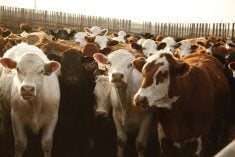After 2002’s cruel calving season, devastating drought and record losses in the feeding sector, farmers and ranchers dreamed 2003 would be a better year.
The dream vanished when federal agriculture minister Lyle Vanclief announced at an Edmonton news conference on May 20 that a cow from a remote northern Alberta farm had been diagnosed with BSE, a fatal brain wasting disease that had decimated Great Britain’s beef industry in the 1990s.
“This was an unprecedented event for our country,for our industry,” Alberta agriculture minister Shirley McClellan said nearly a year after that fateful day.
Read Also

Growth plates are instrumental in shaping a horse’s life
Young horse training plans and workloads must match their skeletal development. Failing to plan around growth plates can create lifelong physical problems.
“We didn’t have a guide book or a plan or a set of what you should do in the event of this.”
All commerce halted as Canada’s major trading partners – the United States, Mexico, Japan and another 30 nations – banned products from Canadian ruminant animals.
Auction markets stopped sales as uncertainty swept through sale barns. Cattle prices lost 75 percent oftheir value.
“On May 25, I thought the industry was probably done for in my life,” said Neil Jahnke, past-president of the Canadian Cattlemen’s Association.
“We’ve come out of it in tremendous shape, considering everything that did happen.”
He and his colleagues moved into disaster mode withdaily meetings tohandle the crisis. Rather than hiring a professionalpublic relations firm, they decided to rely on the credibility of Canadian beef producers to tell thestory to the public.
“If we did anything wrong, it was thinking that we as a country would be treated differently than other countries with BSE,” said CCA president Stan Eby.
“We felt because of the firewalls we had in place, we would have been treated differently. In effect, we were not. We were probably too na•ve at that stage.”
While cattle producers met to discuss animal health and financial concerns, the Canadian Food Inspection Agency launched an exhaustive search for the cow’s history and herd mates.
A national identification agency established two years earlier was one of the cornerstones of the investigation. It did not have enough history to fully track all animals involved, but provided a starting point that was later praised by an international team evaluating Canada’s response to the disease.
Investigators learned the cow showedup for slaughter at a provincial abattoiron Jan. 31, 2003. It was obviously sick and unable to walk and a meat inspector condemned it due to a post-mortem finding of pneumonia.
The head was removed and sent to the Alberta provincial laboratory for BSE testing under routine surveillance. No part of the cow entered the human food chain, but the carcass was rendered into animal feed.
The lab was backlogged with chronic wasting disease tests on deer and elk heads, so the frozen brain tissue was not diagnosed until May 16. Confirmation followed on May 18 at Canada’s national laboratory and at the international reference laboratory in the United Kingdom on May 20.
The CFIA investigation eventually ordered more than 2,700 animals in Alberta and Saskatchewan destroyed and tested. All results were negative.
The CFIA concluded the cow was probably born in March 1997 and ate infected meat and bone meal products before Canada legislated a feed ban inAugust 1997.
The original source of the infection was likely from cattle imported into Canada or the United States from the United Kingdom in the 1980s, before BSE was detected in that country. Some of the animals were slaughtered or died and entered the North American animal feed system before the ban.
To assure international customers Canada wasserious about food safety, federal regulations were changed to ban specified risk material, such ascattle brains, lymphatic and central nervous tissues from the human food supply.
On Aug. 10, the U.S. announced it would start accepting certain boneless meat cuts and Canadians looked forward to renewed live trade on Jan. 4, 2004, once the Americans completed a rule change and public comment period. That stopped on Dec. 23 when the U.S. announced that a BSE infected cow had been found in Washington state.
Independent CFIA and U.S. Department of Agriculture investigations found the eight-year-old Holstein had been born on an Alberta farm.
Despite BSE on the front pages of the international press, consumers never backed away from beef.
“Canadians have been quite remarkable around the whole issue,” said CCA executive vice-president Dennis Laycraft.
“What they really want to do is have good, straightforward answers and an open and honest assessment of what is going on and there is a commitment to doing that.”
Nevertheless, industry leaders agree a new reality exists. There are two classes of cattle – those younger than 30 months and those older than 30 months.
“That’s all part of what we call the new reality,” Laycraft said.
“These are changes we will be living with for many years as a minimal risk country.”
Officials also agree that the integration of the North American beef market is another reality.
“Realistically we are going to approach this on a Canada-U.S. basis,” Laycraft said.
“We hope to see the movement of live cattle moving in both directions. At the end of the day, we believe consumers and the industry want to be comfortablethat the beef they eat, whether it is processed inAlberta or Idaho, is safe.”















